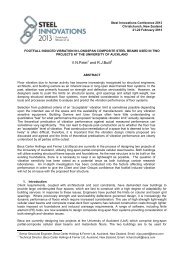Environmental Impacts of Multi-Storey Buildings Using Different ...
Environmental Impacts of Multi-Storey Buildings Using Different ...
Environmental Impacts of Multi-Storey Buildings Using Different ...
Create successful ePaper yourself
Turn your PDF publications into a flip-book with our unique Google optimized e-Paper software.
- 52 -• evaluating the potential environmental impacts associated with those inputs andoutputs;• interpreting the results <strong>of</strong> the inventory analysis and impact assessment phases inrelation to the objectives <strong>of</strong> the study.LCA studies the environmental aspects and potential impacts throughout a product’s life (i.e.cradle-to-grave) from raw material acquisition through production, use and disposal. Thegeneral categories <strong>of</strong> environmental impacts needing consideration include resource use,human health, and ecological consequences.”6.2.3 Elements <strong>of</strong> an LCAAn internationally accepted framework for LCA methodology is defined in AS/NZS ISO14040 and 14044. These standards define the generic steps which have to be taken whenconducting an LCA. The following section will explain these steps and give examples on howthey can be applied to the building industry.Four different phases <strong>of</strong> LCA can be distinguished:6.2.3.1 Goal and Scope DefinitionThe goal and scope <strong>of</strong> the LCA study are clearly defined in relation to the intendedapplication. This includes a detailed description <strong>of</strong> the reasons for undertaking the study, aswell as the intended audience and the intended application <strong>of</strong> the results.Having defined the goal <strong>of</strong> the study, scoping involves defining the functional unit, systemboundaries and other requirements for the study, such as data quality, and choice <strong>of</strong>environmental impacts to be analysed in the “impact assessment”.6.2.3.2 Inventory AnalysisThe inventory analysis involves the actual collection <strong>of</strong> data and the calculation procedures.The relevant inputs and outputs <strong>of</strong> the analysed product system are quantified and produced asa table. These are the material and energy inputs, and product and emission outputs to air,water and land.In an LCA, the material and energy flows should be “drawn from the environment ... ordiscarded into the environment without ... human transformation” [ISO 14040]. Thus theoverall product system should extend upstream to primary resources, and downstream to thepoint where material is emitted into the environment in an uncontrolled way.The initial phase is to develop an “input-output” table <strong>of</strong> the product systems. This would, forexample, be a kg <strong>of</strong> concrete, kWh <strong>of</strong> electricity used and km <strong>of</strong> transport, including the litres<strong>of</strong> diesel consumed. A detailed inventory is then compiled; for concrete this includes theamount <strong>of</strong> gravel, sand, crude oil and all related emissions, e.g. kg <strong>of</strong> CO 2 emissions.At the end <strong>of</strong> the life cycle, treatment <strong>of</strong> solid waste should be considered as part <strong>of</strong> theproduct system. This means that ‘waste’ does not leave the product system analysis but isdealt with within the system boundaries.
















